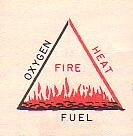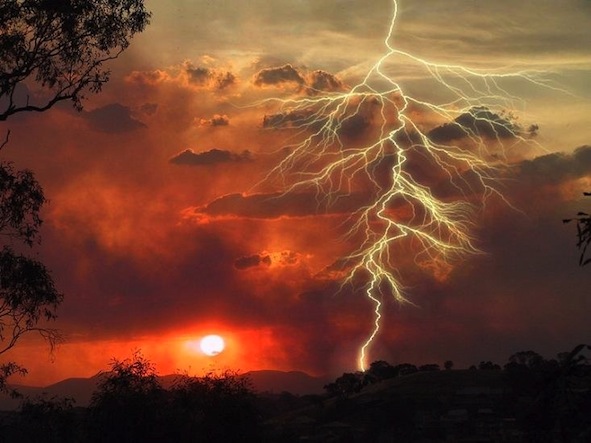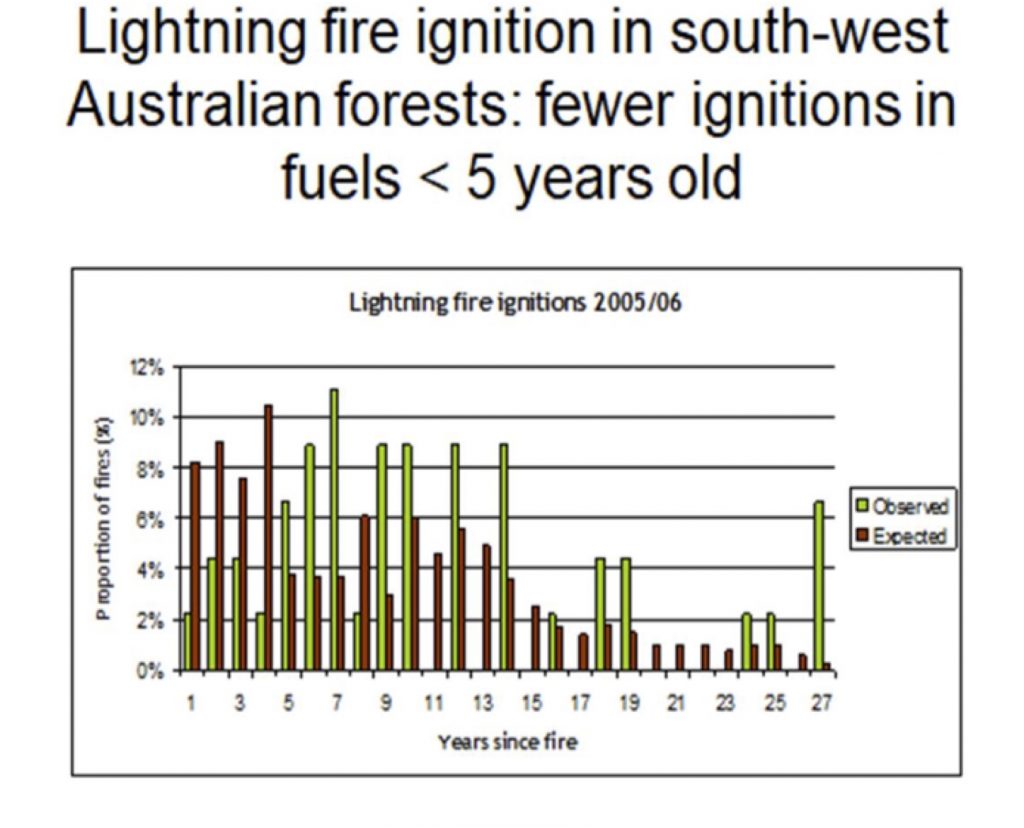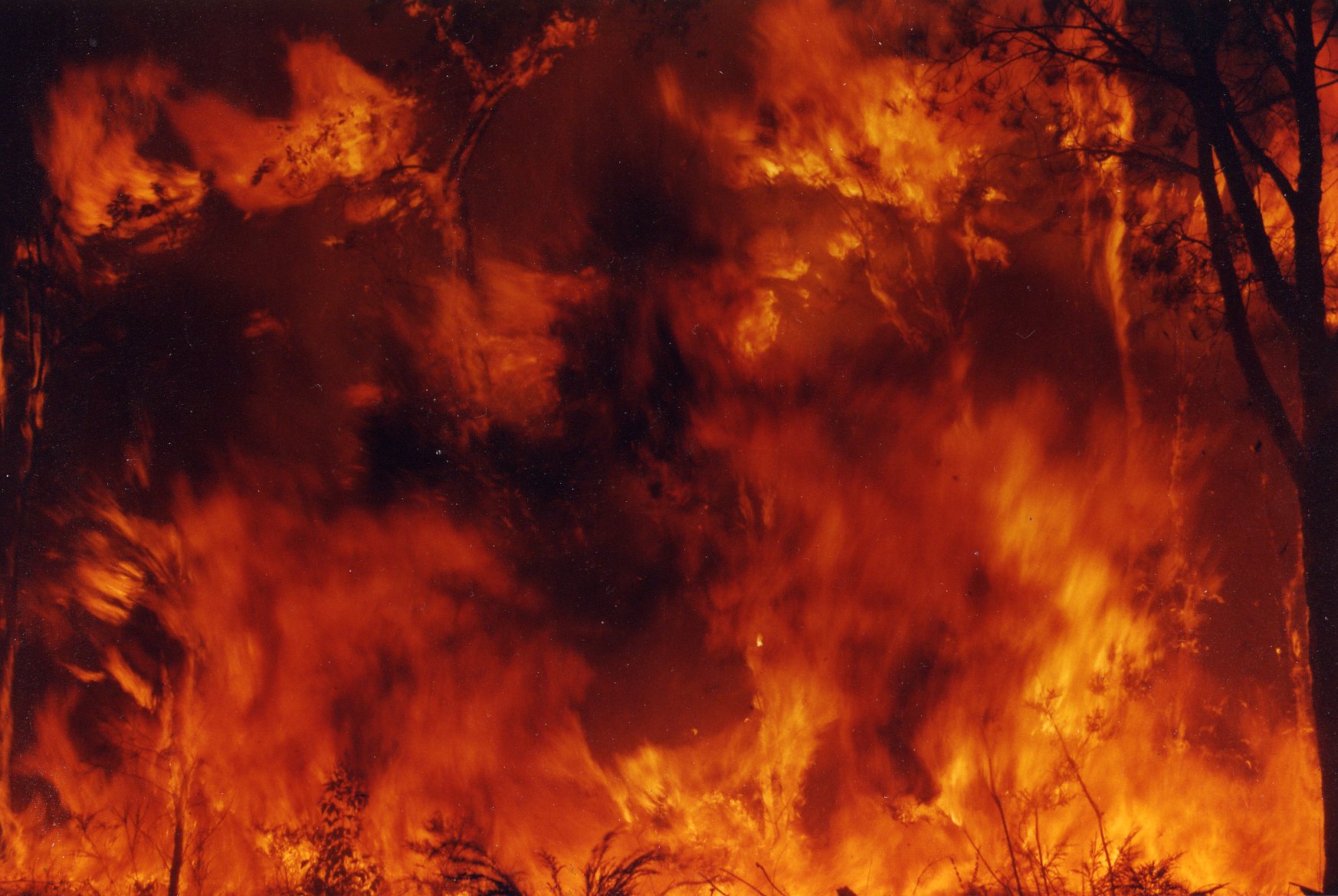Bushfire Basics
The Elements of Fire
The “Fire Triangle” illustrates the three essential components of a bush fire: heat, oxygen and fuel. If any of these three is missing, fires cannot start or keep burning.
Fresh oxygen is always being delivered to a fire by the wind and cannot be controlled.
Heat cannot be usefully reduced in a summer bush fire even with large helicopter water tankers. Pouring water on a fire traditionally used by firemen in urban areas to put out fires in houses and factories where there is ready access to fire hydrants and mains water supplies. In a forest fire situation in Western Australia, the huge quantities of water required to put out a fire are simply not available.
Fuel is the only element of the fire triangle which can be controlled by land managers. If bushland fuel levels are reduced before a summer bush fire starts, the fire will burn less intensively, will spread less rapidly, will cause less damage and can more easily (and more safely) be controlled by firefighters.
This is the principle on which the practice of fuel reduction burning (FRB) is based. The whole forest fire control strategy in Western Australia was built around this practice and was used with great success in State forests from 1961 to about 1990. This 30-year period has provided the evidence for the success of the burning program and its lack of harm to bushland.
Causes of Bushfires
The main causes of bush fires in Western Australia are:
- Accidents, such as vehicle fires.
- Human carelessness, for example, from discarded cigarette butts or escapes from campfires.
- Arson.
- Lightning.
It is not possible to completely eradicate bushfires. Even if there were no accidents, and no acts of human carelessness or incendiarism, bushfires would still be started by lightning, as they were for many millennia before the arrival of humans on the Australian continent. However, we can minimize the number of human-caused fire ignitions by public awareness programs, and much effort has been devoted to this over many years. Despite this effort, we still have large numbers of arson ignitions each fire season.
Sadly, the number of incidents of arson has increased significantly in recent years, which would indicate that there is a limit to the value of education programs. It is possible that a dramatic increase in the penalties for arson might reduce its incidence, but it is most unlikely to eliminate it. Arsonists are frequently not rational and do not weigh the possible consequences of their actions against likely penalties. Furthermore, in the current international political climate, we have to consider the possibility that terrorists might use arson as part of a disruptive program.
If we accept that there will still be a serious number of bushfire ignitions each fire season, then the next best thing we can do is to minimize their impact by suppressing them while they are small or managing bushland fuel in a strategic way to minimize the intensity of fires that do occur.
Lightning-Caused Forest Fires
Low forest fuel levels reduce the number of severe bushfires in Western Australia, as shown by two studies conducted by fire researchers based on the fire statistics that have been kept since about 1962. Dr Lachlan McCaw has studied the incidence of lightning -caused wild/bushfires attended by firefighters within WA South-west forests in relation to the fuel age (years since last fire).
In fire season 2005-06, a total of 338 lightning-caused fires were suppressed by CALM/DEC fire fighters within SW forests. He worked on the reasonable premise that lightning caused fires should be randomly distributed at a landscape scale, making the expected incidence of ignition to be directly proportional to the area of each fuel age class. As the figure below indicates, Dr McCaw found the following. Analysis of fire statistics for forests in south-west Western Australia shows that lightning-caused fires are less likely to occur in areas where the fuel is less than five years old (n= 45 fires). Under the current burning program, the area with fuel less than three years old makes up around 25% of the forest estate. The fact that there are very few fires occurring in this area, and those that do are easily suppressed, makes a very substantial difference to the total fire load during lightning storms when suppression forces can be easily overwhelmed by a large number of fires occurring in a very short timeframe.
In years three and four after burning surface fuels may well have a continuous cover but fuel loads are light and lightning fires may be suppressed by light rain associated with a thunderstorm passage before they are detected. However if fuels are heavy, lightning fires may not be suppressed by quite substantial rainfall because fire burns deep into the fuel bed and moisture does not penetrate to all areas of combustion. Very often lightning ignitions may remain smouldering in heavy fuel and flare up several days after the storm as the fuel dries.
Parts of a Bushfire
Firefighters describe a bushfire by its sectors. The headfire is that part of the fire perimeter moving fastest, usually driven by strong winds. The flank fires are the two areas behind the headfire where the fire edge is moving more slowly at more or less right angles to the headfire direction. The tailfire or backfire is the part of the fire perimeter where it is burning slowly back against the wind.
[click the Resources Menu to see Anatomy of a Bushfire by Dr Peter Attiwill, of the University of Melbourne]
Types of Fire
The critical thing in a fire in bushland is its intensity. A low intensity fire would have a flame height of up to about 60 cm, emits between 20 and 500 kW/meter of fire length, and moves only slowly and is easy to control, even with hand tools such as a rake. It is sometimes called a ground fire. Such fires are normally quite patchy, cause little or no damage to the bush and often are important in enabling ground flora to regenerate. They also have minimal and temporary adverse effects on animal life. Low intensity fires are used in periodic prescribed burning operations to reduce the amount of litter so that the bush cannot support a high intensity fire.
High intensity fires generate much higher heat outputs, from 1700 to about 3500 kw/metre. Such fires cause significant damage to trees and generally cover the whole ground surface in the fire area. High intensity fires eliminate all local fauna, which can have very adverse effects on fauna numbers if the fire covers an extensive area.
Crown fires start as ground fires, burning in heavy fuels on the bush floor. Heat from the ground fire can be carried by convective and radiative forces up to the tree crowns, and the oil-rich leaves of the eucalypts, as well as many understorey plants, are highly flammable under dry conditions. The ground fire thus creates and supports a running crown fire.
Fire tornadoes resemble the well known tornadoes that periodically devastate parts of the USA, but are much smaller and stay more or less in the same place. They are caused by a localised concentrated fuel supply, and while they are spectacular, they don’t do much harm.
Subterranean fires occur when a bushfire enters an area where a peat or peat-like material has been formed in a swamp that has dried out. These fires are extremely difficult to extinguish and can smoulder for months.
[Click the Resources Menu to view the Glossary of Fire Management Terms]
Fire Behaviour
A bushfire that can be attacked very soon after it starts can usually be controlled. Fuel can be removed by raking around the fire, or by creating a fire line around the fire with bulldozers. Heat can be removed by spraying with water. The supply of oxygen is always difficult to control, except when the fire is very small – for example, a campfire can be extinguished by covering it with soil, thereby depriving it of oxygen.
A bushfire that is not attacked soon after it starts can quickly get out of control. The key factors are:
* The quantity and quality of fuel. Fine, loose fuels burn more rapidly than large, compacted fuels), and drier fuels burn more rapidly than wetter fuels; and
* Weather conditions
* Slope
The forward rate of spread of a bushfire is almost directly proportional to the fuel load for given conditions of moisture content of the fuel and wind speed. These two last variables-moisture content of the fuel and wind speed-have major effects on the rate of forward spread. For example, as moisture content decreases from 20 per cent to 7 per cent, the rate of forward spread increases ten-fold; the rate of forward spread increases exponentially as wind speed increases.
At low intensities, fires spread largely by convection. At higher intensities, direct ignition dominates, both by direct flame contact and by ‘firebrands’ of burning eucalypt bark carried by the wind can ignite new fires (‘spotting’) at great distances ahead of the fire: up to 30 kilometres under severe conditions.
Crown fires are impossible to control directly. Suppression operations can take place only along the fire flanks, attempting to “pinch out” the fire or direct it into a low fuel area where the fuel cannot sustain the crown fire and the flames drop to the ground again, becoming much easier to attack directly.
This is what a crown fire looks like.
You don’t want to see one of these coming at you!
How do we measure the intensity of a bushfire?
The intensity of a fire, or the heat released per unit length of fire edge, depends on the amount of fuel consumed every second, which in turn depends on the speed of the fire and the amount of fuel available for combustion. Fire intensity (I) has the units watts per metre, (W/m). The range of intensities for forest fires is enormous – from 20 to 100,000 kilowatts per metre (kW/m). It is difficult to imagine an intensity of 100,000 kW/m; however, a large, household radiator emits about 1 kW, so imagine 100,000 large radiators, powered and stacked up along every metre!



